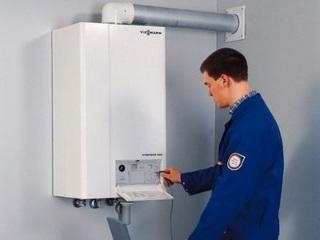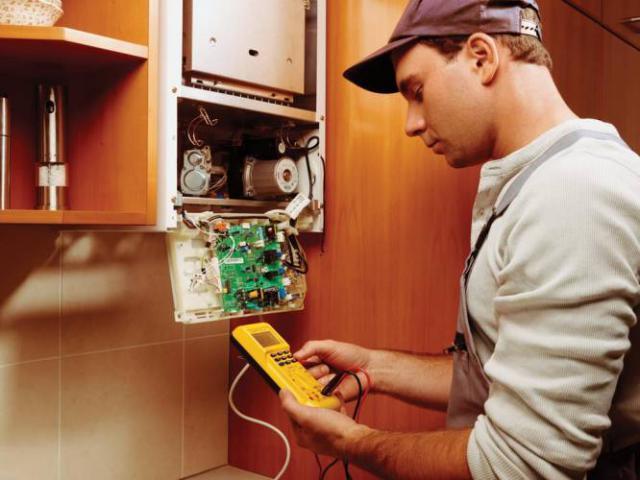How to install a gas boiler in an apartment
Self-installation of a gas boiler in an apartment or a private house is complex both technologically and organizationally.
Important! We must not forget that gas is a fuel of increased danger, and all work must be carried out by specialists. Otherwise, the risk of a fatal error is too great, the result of which will no longer be additional costs, but damage to health, and sometimes to people's lives.
About the types of gas equipment
Installation of gas boilers
In any case, the installation of gas equipment will require going through the authorities, obtaining the necessary permits and a whole bunch of various documents. Both devices and the room itself must meet the requirements and standards laid down in the regulatory documentation. Installation of units must be carried out according to the rules. Nevertheless, before starting a trip to regulatory organizations, it is worth understanding the types of gas equipment used for heating and hot water supply.
To create a full-fledged heating and hot water supply system, you will need to install a double-circuit boiler. The unit must have all the necessary automation. Such devices are expensive, and their installation should be carried out only by specialists.
The budget option is the use of gas equipment only for hot water. That is, we are talking about a gas column. Compared to electric heaters, it is more efficient and cheaper to operate. Even an expensive device will pay off in about a year and a half. Here it must be borne in mind that its installation is not permissible in all apartments. The advantage of water heaters is that they can be easily installed on your own. Deciding which option to choose should be based on specific conditions.
Boiler house at home
A full-fledged boiler room based on a gas boiler can be equipped in a country wooden house, in a cottage, and in an ordinary city apartment.
Its "heart" is a double-circuit boiler with automatic systems. Automation provides not only security, but also the efficiency of the operation of the entire network. It is from its work that the provision of a comfortable temperature regime and the possibility of reducing gas consumption during the operation of the device depend.
Despite all its advantages with automation, it has one important nuance. In the event of a power outage, the unit will switch to minimum space heating mode.
About installation rules
There are a number of requirements for the installation of gas equipment:
- The vast majority of models need to be placed in a separate room. The exception is wall-mounted units - they can be mounted in non-residential rooms, for example, in the kitchen or in the bathroom, if their dimensions allow. Before installing the boiler, it is necessary to ensure the required ventilation in the boiler room.
- The volume of premises for the installation of gas equipment with a closed chamber is not regulated, but the area must comply with the standards. In addition, the unit must have an outlet to the flue. It is unacceptable to bring it to the ventilation ducts.
- Horizontally located parts of the gas duct cannot have a length of more than 3 meters and have more than three turns. The outlet of the gas duct must be raised above the roof level by at least a meter.
- Wall models are mounted at a distance of 800 mm or more from the floor surface. No objects should be placed under the boiler, and a metal sheet must be laid on the floor. An expansion tank and an air valve must be installed.
Do not install gas equipment in the following types of premises:
- In apartments of an apartment building without a main gas duct, these are most of the houses of the old building.
- In rooms with false ceilings and capital mezzanines.
It is almost impossible to install a floor model in an apartment of a multi-storey building. After all, this will require a serious redevelopment with all the ensuing problems and costs. There are no restrictions on the installation of such equipment in a private house. Here it is better to make a separate boiler room, for example, in an extension. This room must meet the following standards:
- Entrance doors - not already 80 cm.
- Without fail, there must be a chimney that goes either to the roof or through the wall to the outside.
- The height of the boiler room must be at least 2.2 m. The room is equipped with a ventilation system.
A double-circuit boiler with automation will require the allocation of a separate branch of electrical wiring. An additional 20 A machine is installed on it. It is desirable to provide backup power to the automation, capable of supporting its operation in normal mode at least during the day. To do this, you can purchase a diesel generator or a UPS - an uninterruptible power supply.
Serious requirements are placed on the gas duct. Its minimum diameter is 110 mm, regardless of the power of the installed equipment. The optimal diameter of the flue is calculated based on the power characteristics of the unit - the higher the power, the larger the diameter.
Boiler connection

Gas heating boilers installation and configuration
The main parameter when choosing a gas boiler is its power. It should be sufficient to ensure the normal functioning of the heating network, but at the same time not excessive. With excess power, the risk of cracking the heat exchanger is high. The so-called acid condensate can also form when the return temperature drops below the gas dew point - 56 degrees. The high power unit quickly warms up the system and goes into standby mode until the temperature drops to certain parameters. After cooling, the boiler turns on again, but powerful heat exchangers have a high thermal inertia, so acid condensate may fall out before it is reheated.
The optimal power should be determined on the basis of thermal engineering calculations. The excess power must be within the allowable run-out. In a private house, heat engineering calculations will have to be done on their own or invite specialists. For apartment buildings, such data can be found in the technical inventory bureau.
Before installing the boiler, it is necessary not only to equip the room, but also to collect the necessary documentation:
- Contract for the supply of gas - when installing a water heater, it will not be required.
- Documents for the meter - it is forbidden to connect gas heating and hot water equipment without this device.
- Documents from the BTI on making changes to the technical passport of a house or apartment. The new plan should take into account the location of the boiler room.
- Technical passport for boiler equipment.
At this stage, you can submit an application to the gas service for the development of project documentation and specifications. You can install the device itself on your own until the finished project is received, but on condition that the room fully complies with the standards and is approved by the regulatory authorities. Gas piping should only be done by employees of the gas services. Prior to commissioning, a suitability statement must be obtained from a gas service engineer.
If the boiler was connected to the gas main on its own, there is practically no chance of getting an engineer's opinion. Such work should be carried out only by gas specialists. You can independently mount the hydraulic and electrical piping of the boiler. As a rule, all the necessary requirements and instructions can be found in the instructions for the device.
Project and TU

Boiler check
The project and specifications (technical specifications) are the most important documents for the installation of a gas autonomous heating network. Specifications are drawn up in the gas service. In fact, this document is an official permission to install equipment. For premises that fully comply with the requirements of regulatory documentation, registration of specifications takes about 14 days.
Project documentation is developed after receiving the specifications. In fact, it is a diagram of the installation of the unit and the laying of the gas pipeline. For a private house, the project should include a scheme for passing the highway through the site. This documentation is also developed only by licensed design professionals.
Approvals
Even documents developed by specialists must be approved by the controlling gas services. All this can take up to three months - depending on the complexity of the developed project. Together with the project documentation, it is necessary to submit to the gas services:
- Technical passport of the heater and operating instructions.
- Equipment certificates.
- The conclusion of the examination.
Let's start installation

Installation diagram of a double-circuit gas boiler
Wall and floor gas boilers must be installed by specialists licensed to perform such work. Work is carried out in a room with a temperature of at least +5 degrees and in several stages:
- Preparation of a hole through which a coaxial pipe or gas duct will be output.
- Unit installation. Wall - on the bracket, floor - on a pre-prepared place.
- Connection in hydropiping.
- Installation of a gas valve, a meter, if it has not been installed earlier, and sensors.
- Connecting the unit to the electrical harness and grounding it.
- Conclusion of a coaxial pipe outside the house.
- Filling the system with coolant and pressure testing.
- Check for gas leaks.
Conclusion
Regardless of the type of equipment you purchased, or the apartment, only gas specialists should deal with it. Independent work is allowed only partially and provided that they do not require intervention in the gas main . All documentation on the basis of which the boiler is installed must be approved. Only the simplest water heaters, that is, gas water heaters, are subject to self-installation.
 Masonry mortars for brick kilns
Masonry mortars for brick kilns Why do the windows fog up in the apartment
Why do the windows fog up in the apartment Construction and schemes of brick ovens
Construction and schemes of brick ovens How to lay paving slabs: tips and tricks
How to lay paving slabs: tips and tricks How to drill bathroom tiles
How to drill bathroom tiles Monolithic slab on coarse soil
Monolithic slab on coarse soil Which electric heater is economical
Which electric heater is economical